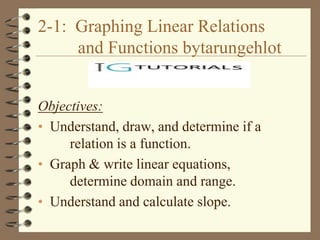
Graphing linear relations and functions
- 1. 2-1: Graphing Linear Relations and Functions bytarungehlot Objectives: • Understand, draw, and determine if a relation is a function. • Graph & write linear equations, determine domain and range. • Understand and calculate slope.
- 2. Relations & Functions Relation: a set of ordered pairs Domain: the set of x-coordinates Range: the set of y-coordinates When writing the domain and range, do not repeat values.
- 3. Relations and Functions Given the relation: {(2, -6), (1, 4), (2, 4), (0,0), (1, -6), (3, 0)} State the domain: D: {0,1, 2, 3} State the range: R: {-6, 0, 4}
- 4. Relations and Functions • Relations can be written in several ways: ordered pairs, table, graph, or mapping. • We have already seen relations represented as ordered pairs.
- 5. Table {(3, 4), (7, 2), (0, -1), x y (-2, 2), (-5, 0), (3, 3)} 3 4 7 2 0 -1 -2 2 -5 0 3 3
- 6. Mapping • Create two ovals with the domain on the left and the range on the right. • Elements are not repeated. • Connect elements of the domain with the corresponding elements in the range by drawing an arrow.
- 7. Mapping {(2, -6), (1, 4), (2, 4), (0, 0), (1, -6), (3, 0)} 2 -6 1 4 0 0 3
- 8. Functions • A function is a relation in which the members of the domain (x-values) DO NOT repeat. • So, for every x-value there is only one y-value that corresponds to it. • y-values can be repeated.
- 9. Functions • Discrete functions consist of points that are not connected. • Continuous functions can be graphed with a line or smooth curve and contain an infinite number of points.
- 10. Do the ordered pairs represent a function? {(3, 4), (7, 2), (0, -1), (-2, 2), (-5, 0), (3, 3)} No, 3 is repeated in the domain. {(4, 1), (5, 2), (8, 2), (9, 8)} Yes, no x-coordinate is repeated.
- 11. Graphs of a Function Vertical Line Test: If a vertical line is passed over the graph and it intersects the graph in exactly one point, the graph represents a function.
- 12. Does the graph represent a function? Name the domain and range. Yes x D: all reals R: all reals y Yes x D: all reals R: y ≥ -6 y
- 13. Does the graph represent a function? Name the domain and range. No x D: x ≥ 1/2 R: all reals y No x D: all reals R: all reals y
- 14. Does the graph represent a function? Name the domain and range. Yes x D: all reals R: y ≥ -6 y No x D: x = 2 R: all reals y
- 15. Function Notation • When we know that a relation is a function, the “y” in the equation can be replaced with f(x). • f(x) is simply a notation to designate a function. It is pronounced „f‟ of „x‟. • The „f‟ names the function, the „x‟ tells the variable that is being used.
- 16. Value of a Function Since the equation y = x - 2 represents a function, we can also write it as f(x) = x - 2. Find f(4): f(4) = 4 - 2 f(4) = 2
- 17. Value of a Function If g(s) = 2s + 3, find g(-2). g(-2) = 2(-2) + 3 =-4 + 3 = -1 g(-2) = -1
- 18. Value of a Function If h(x) = x2 - x + 7, find h(2c). h(2c) = (2c)2 – (2c) + 7 = 4c2 - 2c + 7
- 19. Value of a Function If f(k) = k2 - 3, find f(a - 1) f(a - 1)=(a - 1)2 - 3 (Remember FOIL?!) =(a-1)(a-1) - 3 = a2 - a - a + 1 - 3 = a2 - 2a - 2
